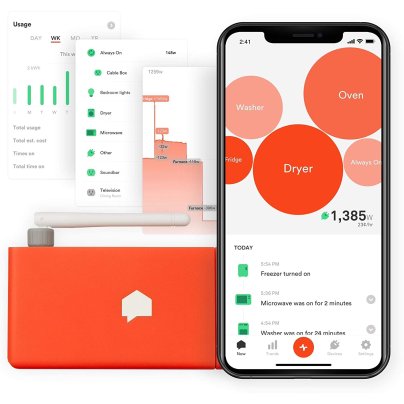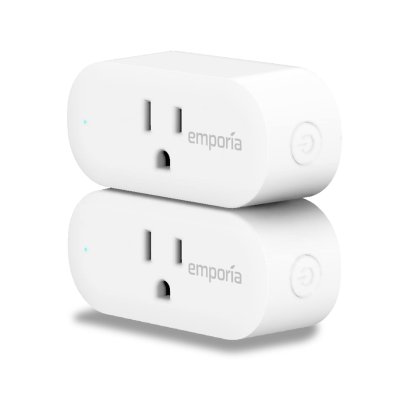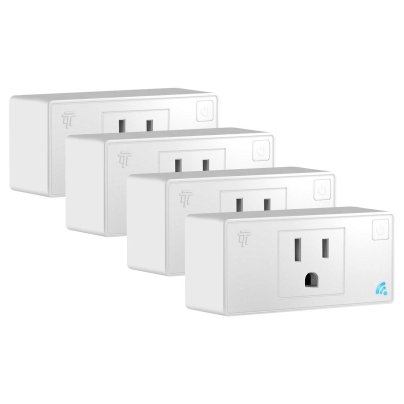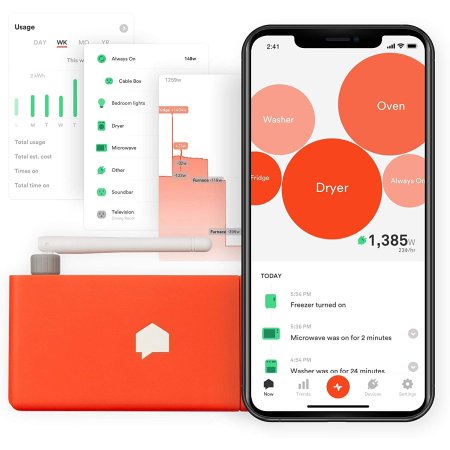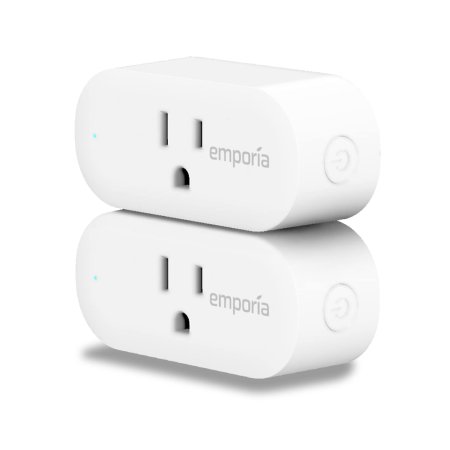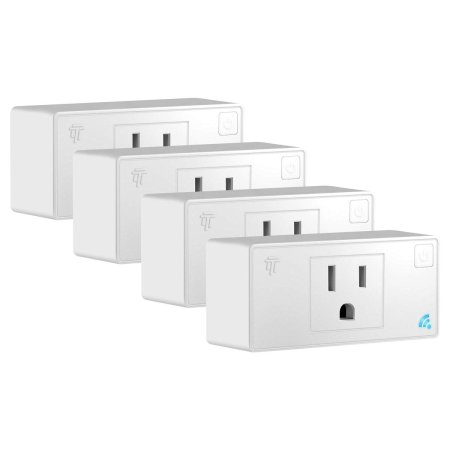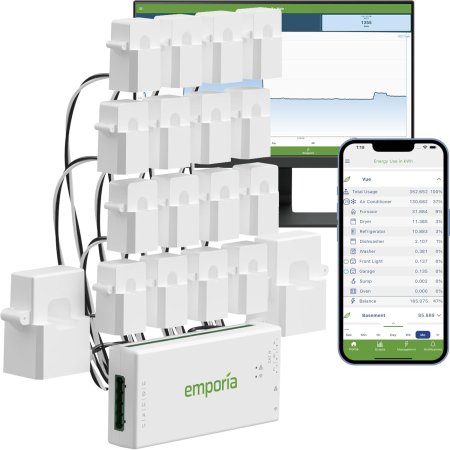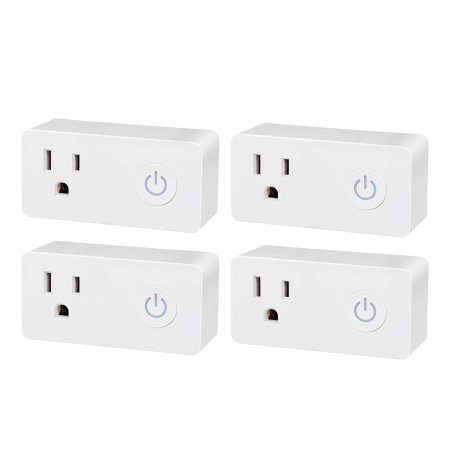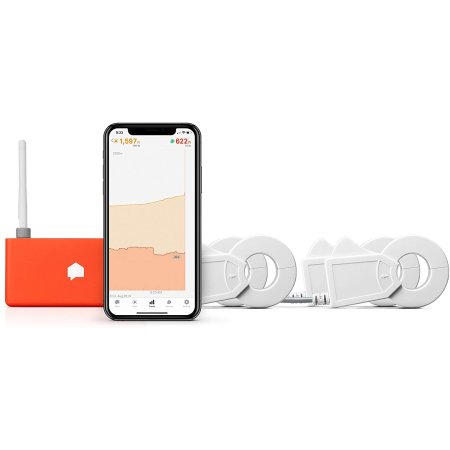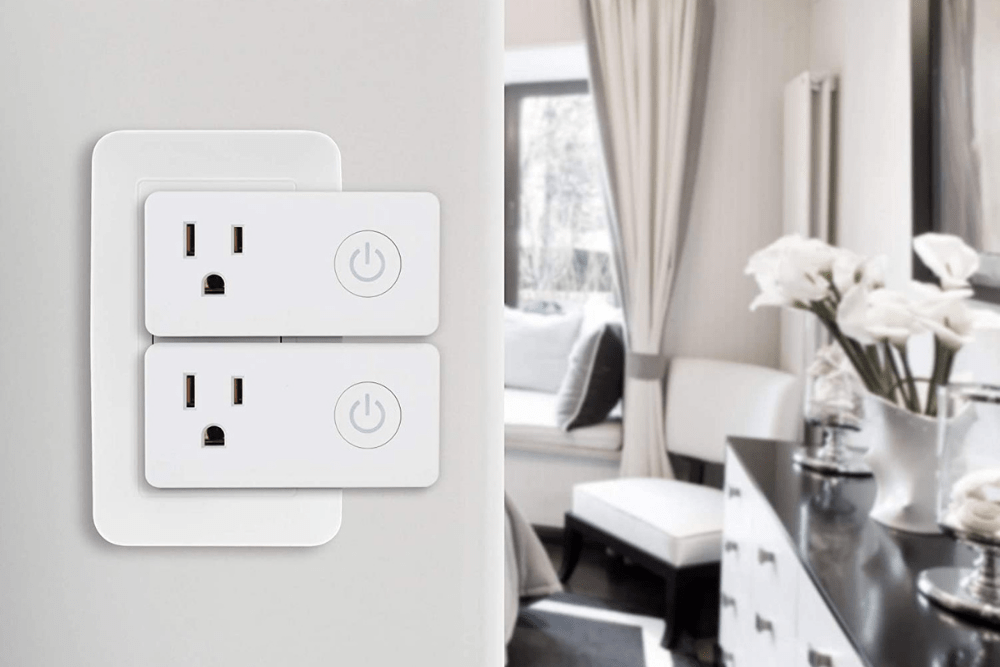
We may earn revenue from the products available on this page and participate in affiliate programs. Learn More ›
With energy costs on the rise, using a home energy monitor to pinpoint how and where you use electricity is a smart way to lower your bill. Rather than waiting for a monthly statement that only shows your home’s total energy consumption, getting real-time usage data can help you increase energy efficiency and save money.
A home energy monitor can catch appliance inefficiencies, sync with smart-home tools, and even calculate solar system energy production. They use technology to monitor energy use as it occurs and break down the energy spent in kilowatts and even dollars and cents.
To determine which home energy monitors would be most useful in your home, we spoke with Mike Naughton, the founder and CEO of Integrity Energy, a commercial energy company in Ohio. Based on his insights and our independent research, we chose the Sense Home Energy Monitor as our top pick for its ease of use and comprehensive feature set. If you’re ready to stop wondering why your electricity bill is so high, one of the best home energy monitors can show you exactly where your home’s energy goes.
- BEST OVERALL: Sense Energy Monitor
↓ Jump to Review - RUNNER-UP: Emporia Energy Smart Plug Energy Monitor
↓ Jump to Review - BEST BANG FOR THE BUCK: TopGreener Mini Smart Wi-Fi Plug-In
↓ Jump to Review - UPGRADE PICK: Emporia Energy Vue Gen 3 Smart Home Energy Monitor
↓ Jump to Review - BEST SMART PLUG: BN-Link Smart Wi-Fi Plug Outlet Outlet
↓ Jump to Review - BEST WITH SOLAR: Sense Solar Energy Monitor
↓ Jump to Review - ALSO CONSIDER: Eyedro Home Energy Monitor
↓ Jump to Review
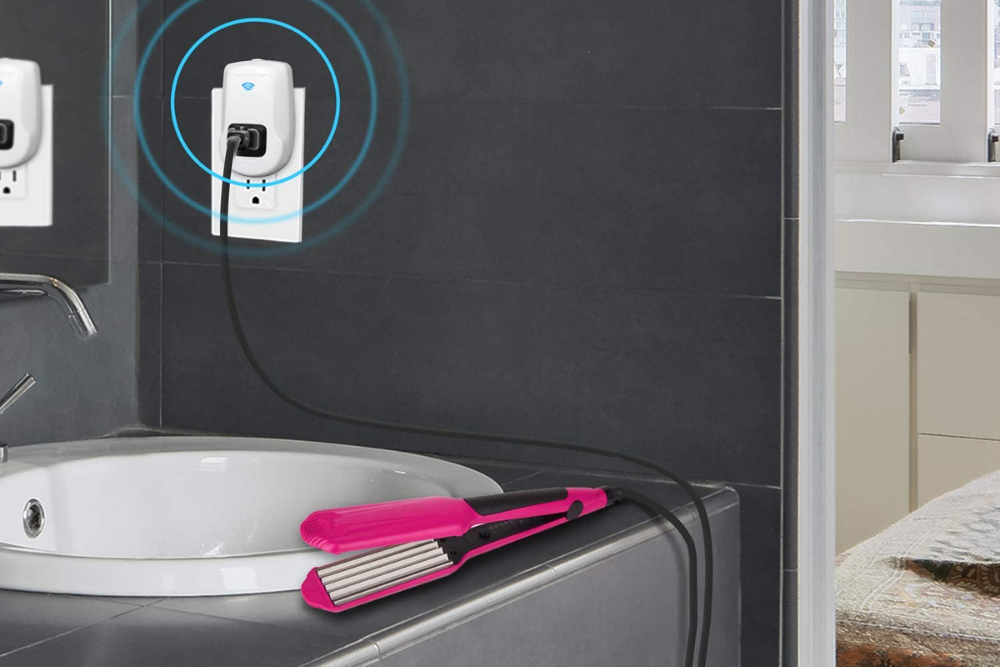
Before You Buy a Home Energy Monitor
When purchasing a home energy monitor, the first step is to determine which type is best for your home’s needs. Occupants of energy-efficient homes might prefer tracking only one or two appliances, while those looking to implement energy improvements across the entire home may want a more comprehensive model.
Outlet Monitoring
A smart plug is the easiest way to measure the energy use of an individual outlet. These are best suited to tracking a few energy-hog appliances rather than everything that runs on electricity. To use a smart plug, simply plug it into a wall socket and then plug an appliance into it. By linking the smart plug to your home’s Wi-Fi, you can see how much energy the appliance uses.
However, smart plug monitors have limitations. They’re not intended for larger appliances, such as laundry machines. Instead, they’re better suited to smaller implements like blenders, hair dryers, and electric weather stations.
Whole-House Power Monitors
For a detailed account of energy use throughout the home, consider a whole-house power monitor. These monitors have sensors that connect to your electrical panel or meter. They track the performance and power consumption of each of your home’s appliances based on their connections to individual circuits.
The sensors gather information, and the electricity usage monitor analyzes the data and transmits insights or notifications to a phone or computer dashboard. When linked to Wi-Fi, home energy monitors provide details on energy use and cost in real time.
Our Top Picks
Choosing the best home energy monitor depends on your needs and preferences. By finding one with the right programs and features, you can enjoy the benefits of an energy-saving home upgrade that pays for itself.
Best Overall
Sense Energy Monitor
Product Specs
- Type: Whole house
- Compatibility: 240-volt (V) breaker
- Energy consumption: Under 5 watts
What We Like
- Whole-house energy tracker
- Customized notifications for critical-use problems
- Tracks when lights are left on or dryer turns off
What We Don’t Like
- Slow to detect devices at first
- Must be installed by an electrician
This Sense electricity monitor offers whole-house energy monitoring for regular, smart, or solar-powered homes. It relies on machine learning to recognize individual devices and lets you know which ones are running for more efficient and informed use. You can see data regarding historical use, identify patterns and waste, set goals to reduce energy consumption, and monitor what’s happening at any moment—even on vacation.
This smart home monitor also makes it easier to save energy by offering voice commands for hands-free updates and energy adjustments. You can view the dashboard through an app and set up customized notifications to know when you’re entering peak consumption zones, how long a device has been running, whether an appliance has been turned off, and more. The only potential downside to this energy monitor is that it must be installed inside an electrical panel, and Sense recommends that a licensed electrician handle this task. Though it may take a few weeks to find all the devices in your home, it offers helpful insights from day one.
What our expert says: “It’s no surprise that Sense’s Home Energy Monitor has become a cornerstone of home energy management. From the moment you install Sense’s system, it immediately starts monitoring and analyzing your household’s energy use.”—Mike Naughton, founder and CEO of Integrity Energy
Get the Sense home energy monitor at Amazon.
Runner-Up
Emporia Energy Smart Plug Energy Monitor
Product Specs
- Type: Smart plug
- Compatibility: 120V outlet
- Energy consumption: Up to 1 watt
What We Like
- Compatible with the Emporia Vue for whole-house monitoring
- Automatically switches appliances off to save energy
- Operates via app and voice controls
What We Don’t Like
- Works with smaller appliances only
- Can only track 1 device per plug
Those looking to test individual appliances can easily track energy use with Emporia’s plug-in energy consumption monitor. It can support 10 amps (A) of continuous load and up to 15A for an hour, making it ideal for small appliances like lamps, coffee makers, and fans. But just because you don’t need an electrician to install it doesn’t mean it’s short on features.
This smart plug offers easy control via voice commands and the Emporia app. You can monitor ongoing energy use and automate on/off settings to save on utility costs. If you’re away from home but want to turn on your lights, you can do that, too. And if you aren’t sure if you clicked off your curling iron before you left, you can find out and fix the issue with its real-time status checker and toggle-off option.
Get the Emporia smart plug home energy monitor at Amazon.
Best Bang For The Buck
TopGreener Mini Smart Wi-Fi Plug-In
Product Specs
- Type: Smart plug
- Compatibility: 120V outlet
- Energy consumption: Not listed
What We Like
- 4-pack offers an excellent value
- Compact size leaves second outlet uncovered
- Offers scheduling and app control
What We Don’t Like
- Some users report issues maintaining a Wi-Fi connection
- Not compatible with loads over 10A
Rather than investing in installing a whole-home system, this four-pack of TopGreener mini energy-monitoring plugs can help you control energy use for multiple appliances at a relatively low price. You can monitor and make adjustments using the TopGreener app, and it also connects to your home’s 2.4 GHz Wi-Fi network for hands-free voice control through Alexa or Google Assistant.
Installation is as simple as plugging these smart outlets into the wall and plugging your small appliances into the outlets. They feature an on-outlet on/off switch, or users can set schedules and timers for automation operation. While some have reported issues using Wi-Fi to set up these plugs, they’re easy to pair manually by holding the power button for 5 seconds and selecting the manual add option through the app.
Get the TopGreener home energy monitor at Amazon, Walmart, or TopGreener.
Upgrade Pick
Emporia Energy Vue Gen 3 Smart Home Energy Monitor
Product Specs
- Type: Whole house
- Compatibility: 240V breaker, 240V/480V split-phase system, or 3-phase Wye system
- Energy consumption: Up to 3 watts
What We Like
- Comes with 16 sensors
- Solar generation net metering capabilities
- Customizable push notifications
What We Don’t Like
- Professional installation is best
- Difficult to retrieve extra data if desired
Receive up-to-the-moment data about energy cost and usage anytime and anywhere with Emporia Energy’s Vue Gen 3 monitor. The monitor comes with 16 sensors that clamp onto the main and individual circuits in the breaker box, which are best attached by a professional, though they come with DIY instructions.
The device monitors larger appliances attached to the individual circuits, but it integrates with smart plugs to monitor smaller appliances, set timers and schedules, and increase control through the Emporia Energy app. Solar homes can use this monitor to see how much excess energy goes back to the grid versus how much energy the home consumes. The app sends notifications based on the data it gathers, so users know which steps to take to conserve energy and control costs.
Get the Emporia Vue home energy monitor at Amazon, Best Buy, or Emporia Energy.
Best Smart Plug
BN-Link Smart Wi-Fi Plug Outlet
Product Specs
- Type: Smart plug
- Compatibility: 120V outlet
- Energy consumption: Not listed
What We Like
- 4-pack of individual outlet monitors
- Voice activation and app control capabilities
- Customizable timer function
What We Don’t Like
- Must be reset if Wi-Fi or power is interrupted
- Reports of individual units within the packs not working correctly
The space-saving design of BN-Link’s smart Wi-Fi outlets enables you to stack two smart outlets on top of each other or leave one wall outlet open for regular use. You can control these plugs manually with their on/off power button, or you can use the Smart Life app or voice commands (via Alexa or Google Assistant) to control and monitor power use, set up automatic timers, or create a schedule for an appliance. Within the app, you can also name each smart outlet based on which appliances are plugged into it.
Though installation is straightforward—simply plug the smart outlets into the wall, plug appliances into the outlet, and connect with a secure Wi-Fi connection—these plugs require a reset if Wi-Fi or power is interrupted.
Get the BN-Link home energy monitor at Amazon, Walmart, or BN-Link.
Best With Solar
Sense Solar Energy Monitor
Product Specs
- Type: Whole house
- Compatibility: 240V breaker
- Energy consumption: Up to 10 watts
What We Like
- Whole-house energy monitoring system
- Tracks solar generation and output
- Customizable notifications
What We Don’t Like
- Electrician needed for installation
- Slow to identify devices
The Sense solar energy monitor identifies individual appliances and offers information about specific devices, such as when they’re on, their efficiency, vampire tendencies, and more. It sends notifications about potential issues, including solar system alerts, and it offers built-in cost calculations to compare the energy produced and energy consumed in a side-by-side view so you can minimize the amount of power you need to purchase.
Sense fits right into your electrical panel and is best installed by a certified electrician. It connects via Wi-i and is controllable with an app or voice commands. The longer it’s plugged in, the more this monitor learns, which helps it determine patterns in energy use and find ways to improve efficiency.
Get the Sense solar home energy monitor at Amazon.
Also Consider
Eyedro Home Energy Monitor
Product Specs
- Type: Whole house
- Compatibility: 120V wall outlet
- Energy consumption: Not listed
What We Like
- Easier setup than most whole-house options
- Delivers plenty of useful data
- No subscription fees
What We Don’t Like
- Only 2 monitoring clips
- Poor installation can cause inaccurate readings
See real-time energy consumption with this easy-to-install whole-home energy monitor from Eyedro. Rather than using an empty breaker, this monitor simply requires you to plug in its module near your electrical panel and connect the included clips. The sensors then feed information to an online dashboard using the provided Ethernet cable, though it also offers Wi-Fi compatibility.
To see energy usage at any time, simply log into the Eyedro website or app. As you turn appliances on and off, the change to energy consumption displays as an update. You can access monitoring reports and bill estimates and receive alerts if the power goes out and the system loses communication. For those looking to monitor more than 10A appliances without having to hire an electrician, the Eyedro is an excellent option.
Get the Eyedro home energy monitor at Amazon or Eyedro.
Jump to Our Top Pick
How We Chose the Best Home Energy Monitors
Our recommendations for home energy monitors include models that can monitor an entire house, specific circuits, or a single outlet. That versatility is helpful for homeowners who need total electrical usage monitoring or who may already have an energy-efficient home and only want to monitor a few devices. For our list of top picks, we included products at a number of price points while prioritizing ease of use, accurate tracking, and the convenience of operation via app or voice-activated controls.
Most of our included options rely on Wi-Fi connectivity, but we also chose a monitor that uses an ethernet cable if you prefer a more steady connection. Several units can monitor solar generation and output, which might be helpful for some homeowners.
What to Consider When Choosing a Home Energy Monitor
To choose which home energy monitor is right for you, you’ll want to consider how much and what type of information will be most valuable. Different monitors might include energy details on a home’s solar system or appliance-specific information only. Some may work via voice commands, have an easy-to-use app, or offer easy installation.
Solar Monitoring
Home solar systems can lower an electric bill by using a solar inverter to transform energy from the sun into alternating current (AC) electricity. These devices track both the energy used and the energy generated and can identify times of peak solar power.
Solar home energy monitors connect to a home’s utility meter to discover and track patterns in energy input and output. Some devices show a side-by-side comparison of this data and send the owner notifications if they detect changes in the amount of energy consumed or produced.
Appliance Recognition
Whole-home electricity monitoring devices plug into individual circuits on the electrical panel. Some of these systems offer circuit-specific details, but smarter systems learn the unique electrical signatures of each appliance and track them individually. Appliance-specific recognition pinpoints the energy use of appliances big and small, and some can even create alerts about details such as an open fridge door.
Appliance recognition allows energy monitors to make more specific recommendations to reduce energy. They can send notifications to unplug a blow dryer, adjust a programmable thermostat, or advise which appliances need to be upgraded to more energy-efficient models. Tracking the energy consumption of each appliance rather than all the appliances attached to a circuit can provide actionable information regarding reducing energy use.
Real-Time Cost Tracking
Your electricity bill is a record of how much energy your home uses weeks after the usage occurs. Tracking how energy gets used in real time enables a home’s occupants to act in the moment to minimize energy waste. Energy monitors may show current tracking in kilowatt-hours and dollars, providing information as to how much energy a family is using and what it costs them.
Ongoing tracking and real-time notifications can uncover behaviors and patterns that contribute to energy overuse. This information helps you find sources of wasted electricity and correct them. A benefit of real-time cost tracking is locating “vampire” appliances that draw electricity in standby mode so they can be unplugged, replaced, or used more efficiently.
Smart-Home Compatibility
Even if you’re already taken steps to make your home a smart home, you can benefit from a home energy monitor. Whole-house smart-home energy monitors fit into the home’s electrical panel and connect wirelessly to other devices in the home. A Wi-Fi–enabled home monitor can communicate and interact with other smart-home devices.
Linking the energy monitor to a smart thermostat or smart plug provides detailed energy-use data and enables users to operate appliances without being near them. These models show up-to-the-second energy use in the home, identify patterns, calculate the costs of operation, and more.
Mobile Apps and Notifications
Once the device is installed, home energy monitors negate the need to read meters or visit the electrical panel. Many systems connect home energy information to a smartphone to deliver instant updates about energy usage.
Many home energy monitors have a downloadable app with a dashboard that tracks usage, trends, and more from a phone or computer. In some cases, the app can review and initiate action items from remote locations. Many also allow users to set up notifications regarding critical use events, peak usage times, instances where energy is being wasted, and other analytics.
Voice Control
Some whole-home and smart-plug energy-tracking outlets are compatible with Google Assistant and Alexa. Syncing the monitor to these digital assistants gives users hands-free capabilities, which can be especially helpful for those with mobility issues or use in areas where an outlet is difficult to reach. Digital assistants can give quick updates, and users can employ voice commands to activate energy-saving tasks, such as turning off appliances.
Programs and Timers
Individualized programs can save energy in the home. Each home energy monitor has a program to manage technology and energy. Some examples of home energy monitor programming possibilities include the following:
- You can program smart systems so that when an alarm goes off, the house heats up, the lights come on, and the coffee maker automatically starts.
- When leaving home, you can program appliances to turn off or go into energy-saving mode.
- If goal setting is important, you can find a home energy monitor to help the household stay on track and reach its energy-saving goals.
- You can set alerts as a reminder to turn off specific devices.
Timers are also helpful features for minimizing energy waste. You can program them so outlets turn off after a specific amount of time to prevent vampire appliances from drawing energy.
Installation
Basic plug-in monitors measure the energy used by individual appliances plugged into a wall socket. To install these models, simply plug them into a wall outlet and plug the appliance into the monitor.
Installing a whole-home energy monitor either inside the electrical panel or near it on a wall is more complex. Typically, the monitor includes sensors that clip to individual circuits and a small unit that analyzes the information. The number of individual circuits to be monitored can influence the choice of which home energy monitor to purchase. Many of these models need to be installed by a licensed electrician. Once they install the hardware, you can connect it to your Wi-Fi and download the monitor’s app.
FAQs
Selecting a home energy monitor requires a bit of research. Here are some of the commonly asked questions and answers about home energy monitors to help you get started.
A home energy monitor has sensors that clip to individual circuits in the electrical panel to measure the amount of energy used by that particular circuit. It transmits this information to a smartphone or computer so you can see how much energy is used at a given time.
Home energy monitors are relatively accurate. Quality energy monitors can estimate usage accurately within 1 percent.
Smart plugs draw about 1 watt in standby mode. Still, the energy they save from limiting power to plugged-in devices makes up for the energy they use, making them a great tool to combat climate change.
Naughton says using a device to monitor electricity usage is an effective way to save on energy. “They’re a great option for hectic households with fluctuating energy needs. They can be used to help your household become more sustainable and keep an eye on your kids’ screen time.”
Both are tools that track electricity usage, but they serve different purposes. Utility companies use smart meters as energy consumption meters to measure your home’s energy use to ensure accurate billing. Home energy monitors are used by homeowners to monitor electricity usage and make it more efficient.
Heating and cooling systems generally consume the most electricity in homes, followed by large appliances like water heaters and refrigerators.
According to Naughton, “Most home energy management systems range from $100 to $600. Costs will vary depending on how sophisticated the software is and your home’s unique layout. Home energy management systems that also monitor renewable energy production from solar panels also tend to be the more expensive option as well.”
The US Department of Energy says standby power accounts for 5 to 10 percent of household energy use and that unplugging your products is a good way to save electricity. They also recommend adjusting your home thermostat while you’re away and asleep to cut down on energy consumption.
